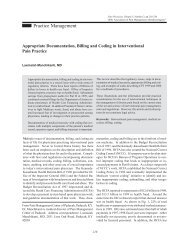ASIPP Practice Guidelines - Pain Physician
ASIPP Practice Guidelines - Pain Physician
ASIPP Practice Guidelines - Pain Physician
Create successful ePaper yourself
Turn your PDF publications into a flip-book with our unique Google optimized e-Paper software.
Manchikanti et al • <strong>ASIPP</strong> <strong>Practice</strong> <strong>Guidelines</strong><br />
48<br />
level. For intra-articular injection he used 2% lidocaine, 1<br />
mL, and 0.5% bupivacaine, 1 mL, along with a 20-mg<br />
methylprednisolone acetate suspension. The two treatments<br />
were equally effective but were disappointing in their therapeutic<br />
effect. A total of 58% of patients in each group<br />
demonstrated significant pain relief at 1-month follow-up.<br />
Based on this report, as a therapeutic measure, posterior<br />
ramus medial branch nerve blockade was proven to be as<br />
effective as intra-articular injection of steroid in low back<br />
pain of probable facet origin, suggesting that facet joint<br />
pain does not have an inflammatory component.<br />
In another study, North et al (377) used diagnostic facet<br />
blocks and incorporated assessment by a disinterested third<br />
party. Following the diagnostic medial branch blocks, 42%<br />
of the patients reported at least 50% relief of pain. Among<br />
40 patients who underwent temporary blocks but did not<br />
undergo radiofrequency denervation, 13% reported relief<br />
of at least 50% at long term follow-up with mean interval<br />
of 3.2 years.<br />
Barnsley and Bogduk (375) studied 16 consecutive patients<br />
with chronic neck pain from motor vehicle accidents and<br />
reported complete or definite relief of their pain in 11 patients.<br />
All of the trials described above face criticism. The randomized<br />
clinical trial by Manchikanti et al (481) is limited<br />
by failure to incorporate a placebo group and to utilize a<br />
major instrument to evaluate the progress. Other studies<br />
by Manchikanti et al (182), Marks et al (380), and Nash<br />
(379) were also limited by failure to incorporate a placebo<br />
group, lack of long term follow-up, and lack of reporting<br />
of outcomes.<br />
Of the four controlled reports evaluating medial branch<br />
blocks, one study evaluating the therapeutic role was of<br />
moderate quality (481). The remaining three studies were<br />
of low quality for therapeutic purposes (182, 379, 380).<br />
In analyzing the type and strength of evidence due to the<br />
availability of only a total of four controlled studies for<br />
consideration, the evidence from two observational studies<br />
was also utilized. The analysis of type and strength of<br />
efficacy evidence shows that medial branch blocks provide<br />
level III (moderate) evidence. Level III - moderate<br />
evidence is defined as evidence obtained from well-designed<br />
trials without randomization, single group pre- post,<br />
cohort, time series, or matched case controlled studies.<br />
Medial Branch Neurotomy<br />
Multiple investigators have studied the effectiveness of<br />
radiofrequency denervation of medial branches in the spine.<br />
Percutaneous radiofrequency neurotomy is a procedure that<br />
offers temporary relief of pain by denaturing the nerves<br />
that innervate the painful joint (482), but the pain returns<br />
when the axons regenerate. Fortunately, relief can be reinstated<br />
by repeating the procedure. Radiofrequency neurolysis<br />
as a treatment of chronic intractable pain began in<br />
the early 1930s. Shealy (483, 484) pioneered spinal facet<br />
rhizotomy in the 1970s, and Sluijter and Koetsveld-Baart<br />
(319) initiated minimally invasive radiofrequency lesioning<br />
for pain of spinal origin.<br />
Numerous reports describe the technique and effectiveness<br />
of radiofrequency thermoneurolysis (319, 377, 482-511).<br />
Neurolytic blocks (512) and cryogenic neurolysis (513)<br />
also have been described. Success with radiofrequency<br />
neurotomy has been reported in the range of 17% to 90%<br />
for management of lumbar facet joint pain. There were<br />
four prospective randomized studies by Lord et al (487),<br />
Van Kleef et al (488) Dreyfuss et al (510), and Gallagher<br />
et al (510).<br />
Lord et al (482) conducted a prospective, double blinded,<br />
placebo-controlled study of percutaneous radiofrequency<br />
neurotomy for management of chronic cervical facet joint<br />
pain. Lord et al (482) compared percutaneous<br />
radiofrequency neurotomy, in which multiple lesions were<br />
made and the temperature of the electrode was raised to<br />
80°C, with a control treatment using a procedure that was<br />
identical except for the facet that the radiofrequency current<br />
was not turned on. This study included 24 patients (9<br />
men and 15 women) with a mean age of 43 years who<br />
presented with pain in one or more cervical facet joints<br />
after motor vehicle injury. The mean duration of pain was<br />
34 months. Facet joint pain was diagnosed with the use of<br />
double-blinded, placebo-controlled local anesthetic blocks.<br />
The results showed that the median time that elapsed before<br />
the pain returned to at least 50% of the preoperative<br />
level was 263 days in the active treatment group and 8<br />
days in the control group. At 27 weeks, seven patients in<br />
the active treatment group and one patient in the control<br />
group were free of pain. The authors concluded that, in<br />
patients with chronic cervical facet joint pain confirmed<br />
by double-blinded, placebo-controlled local anesthesia,<br />
percutaneous radiofrequency neurotomy with multiple lesions<br />
of target nerves could provide lasting relief.<br />
Van Kleef et al (487), in a randomized trial of radiofre-<br />
<strong>Pain</strong> <strong>Physician</strong> Vol. 4, No. 1, 2001
















